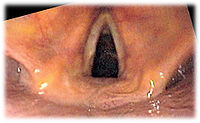
Photo from wikipedia
Background and Aims: Unpredictable difficult laryngoscopy remains a challenge for anaesthesiologists, especially in morbidly obese patients. The present study aimed to determine the efficacy of different sonographic measures as predictors… Click to show full abstract
Background and Aims: Unpredictable difficult laryngoscopy remains a challenge for anaesthesiologists, especially in morbidly obese patients. The present study aimed to determine the efficacy of different sonographic measures as predictors of difficult laryngoscopy in morbidly obese patients undergoing elective surgery. Methods: This observational study evaluated 70 morbidly obese adult patients (body mass index >35 kg/m2) undergoing elective surgery under general anaesthesia with tracheal intubation. Pre-operative clinical and ultrasonographic variables (anterior condylar translation, tongue thickness, hyomental distance and oral cavity height) associated with difficult direct laryngoscopy ([Cormack Lehane (CL) grade>2]) were analysed. The primary outcome was to determine the efficacy of the above-mentioned sonographic measures as predictors of difficult laryngoscopy (CL grade >2). The secondary outcome compared ultrasonographic predictors with clinical predictors in morbidly obese patients for determining difficult direct laryngoscopy. Results: Amongst the primary outcome measures, limited condylar mobility (anterior condylar translation <9.25 mm) [odds ratio (OR) 0.3, confidence interval (CI):1.04-1.22;P<0.001;area under curve (AUC):0.8] and increased tongue thickness >5.85 cm [OR: 3.2, CI: 1.05–10; P < 0.04; AUC: 0.73] were two independent sonographic predictors for difficult direct laryngoscopy by multivariate logistic regression and receiver operating characteristic curve analyses in morbidly obese patients. The secondary outcome suggested that as compared to clinical predictors such as Mallampati grade and thyromental distance, ultrasonographic variables such as tongue thickness and limited condylar mobility (sensitivity: 56.4%, 70.9%, 66.7% and 93.3%, respectively) better predicted difficult direct laryngoscopy in morbidly obese patients. Conclusion: Limited condylar mobility and increased tongue thickness are independent sonographic predictors of difficult direct laryngoscopy in morbidly obese patients.
Journal Title: Indian Journal of Anaesthesia
Year Published: 2021
Link to full text (if available)
Share on Social Media: Sign Up to like & get
recommendations!